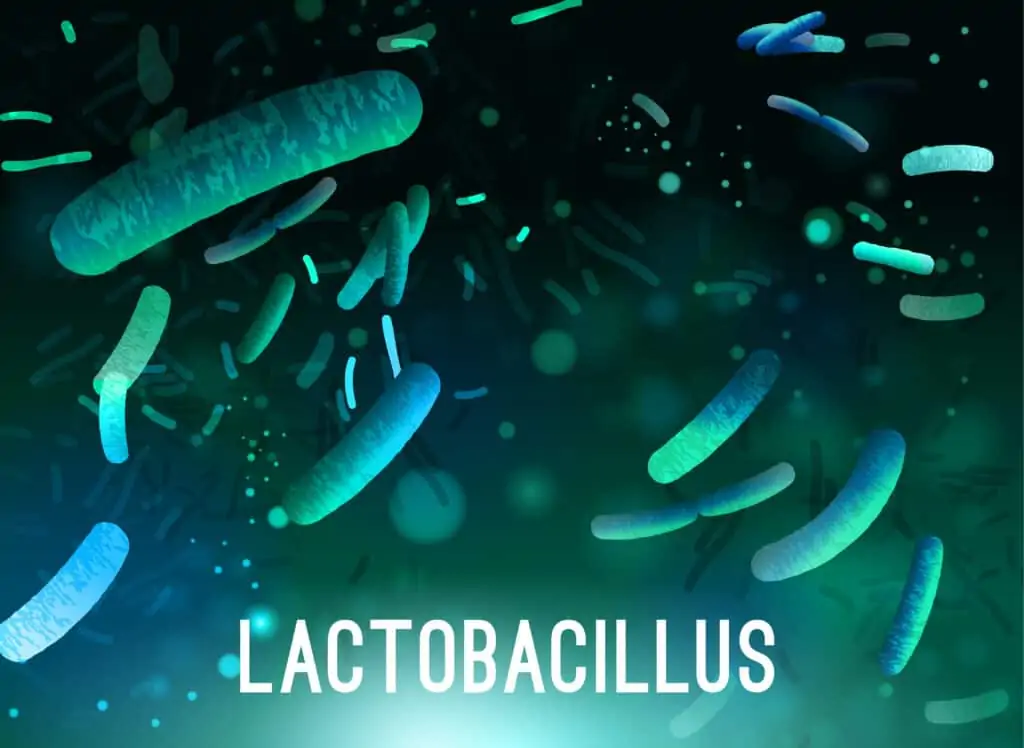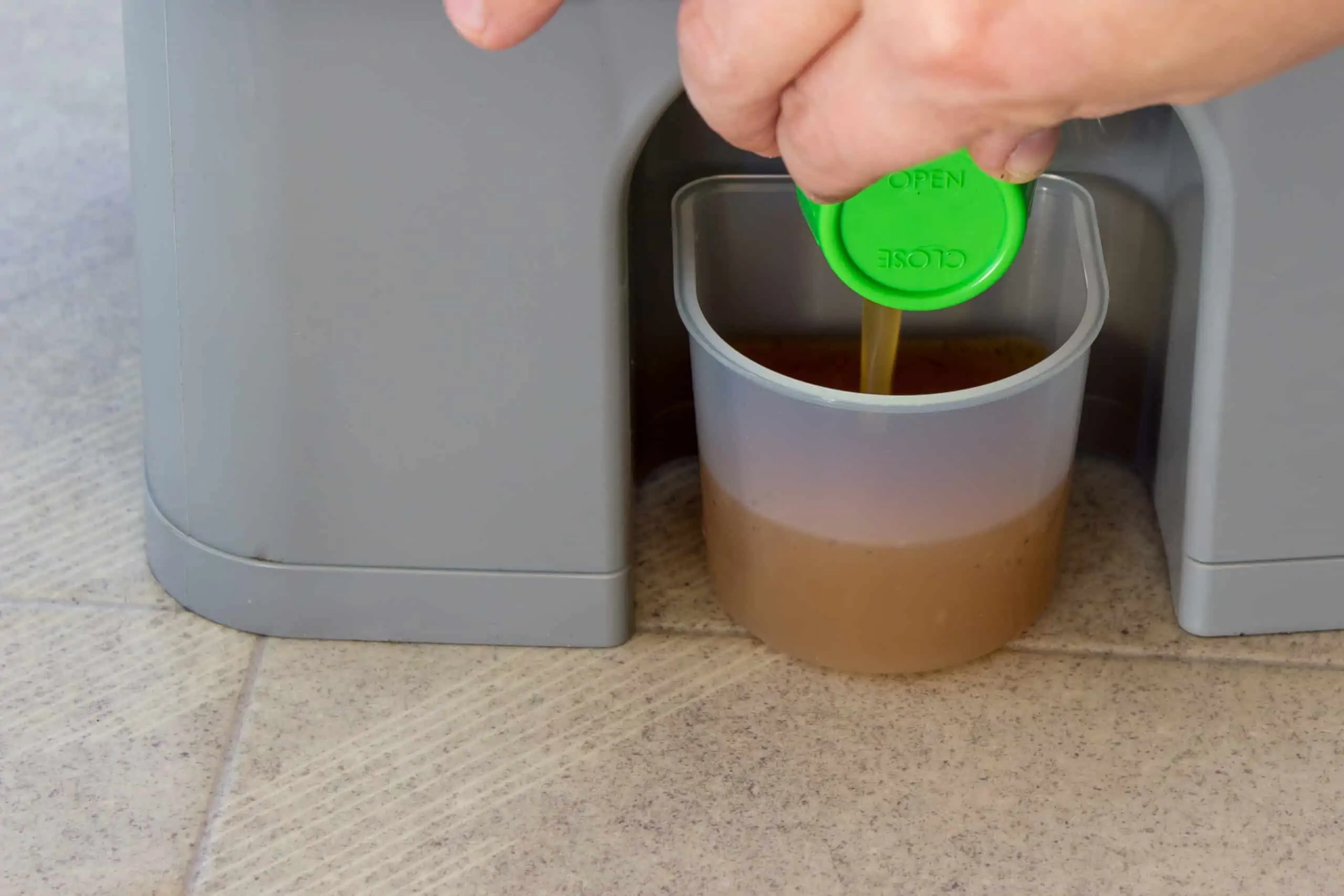As an Amazon Associate I earn from qualifying purchases.
I’m really into kombucha (and telling people about kombucha). It’s one of my many flaws. So you can imagine how excited I was when I heard about Bokashi Tea. I’ve tried just about every type of kombucha tea but this “Bokashi” sounded new and exotic.
I wasn’t nearly as excited to find out that Bokashi is a Japanese word that means “fermented organic matter.” Not my idea of a great tea.
But just because I don’t want to drink it doesn’t mean that I wasn’t excited to find out about what Bokashi Tea is and all the amazing applications it could have in both my yard and house.
I just had to figure out exactly what it was and how to use it.
Bokashi Tea is the acidic liquid that accumulates at the bottom of a bokashi composter or in the designated reservoir. It contains liquids from the composting items (food scraps, etc.) and bokashi microbes. The pH level and acid-loving microbes it contains are responsible for the benefits it provides.
If your bokashi bucket has a drain, you should be able to harvest bokashi tea every couple of days just by turning the knob.
If you don’t have a drain, you might just be out of luck. Your bokashi will still be making juice but it will simply gather at the bottom of the bucket in the layer of browns that you (hopefully) put in place.
Without the bottom-browns (or if you don’t harvest your bokashi juice) your bokashi bucket will slow way down. Why? Because your microbes don’t want to live in juice!
In order to keep your bucket and the microbes that live there happy, harvest your bokashi juice every couple of days, even you’re only getting a couple of ounces every time.
How much you get is heavily influenced by the amount and type of things you’re composting. How much you get, however, does not change how you can use it!
The 6 Uses of Bokashi Juice
There are dozen of potential uses for Bokashi Juice. In fact, my constant need for more juice is one of the things that made me get another bucket and step up my bokashi composting!
While there may be other uses, these are the ones that I feel utilize the unique attributes of bokashi tea the best:
- Septic system aid. The (hopefully) thriving number of microbes in your bokashi tea can give your septic system a boost if it’s sluggish in breaking down waste.
- Clean and clean pipes. Bokashi tea is one of the few things that I’m fine with telling you to throw away! Ever since I started pouring it down my drains I haven’t had a single clogged pipe or slow draining sink. Not only does the acid act as a natural Drano substitute but the microbes work to break down fat, hair, and other common clogging materials. In addition to pipes, bokashi tea can clean and reduce the smell of in-sink garbage disposals.
- Feed plants. Bokashi juice has a significant amount of nutrition for plants. The exact nutrition it provides is dependant on the type of foods or material that you are breaking down.
- Improve soil’s microbial content. One of the main jobs that soil microbes have is to “unlock” the vitamins and minerals in the soil. Without them, plants cannot access what they need to grow.
- Improve sanitation of pet and livestock pens. The microbes in bokashi tea (EM-1) have been shown to reduce odor and sanitize in dog runs, chicken coops, etc.
- Turbocharge outdoor composting systems. All composting methods rely on microbes to break things down. While we typically rely on a compost kickstarter to catalyze the process, adding microbes in the form of bokashi juice can help get things moving as well.
The one thing that you cannot do with bokashi tea (or at least I would not recommend doing) is consuming it. While EM-1 has been shown to be beneficial to the digestive systems of both humans and animals, its form in bokashi tea is not recommended to be used internally. Its acid content as well as the possibility of it containing pathogens, mold spores, etc. make it a hard pass for me.
Can I Add It Bokashi Straight To Soil? (Bokashi Tea Dilution Ratio)
If you played sports in high school and had an old-school coach, he probably told you to drink pickle juice. If I remember anything about my experience of chugging it, it’s that it makes your throat feel like a parched desert. Long story short, acids are not meant to be used directly by living things (like me). Bokashi tea is much the same way.
Despite all the amazing benefits it provides, Bokashi liquid must be diluted before you can use it for plants or soil.
Bokashi Tea should be diluted at a ratio of 100:1 (water:juice) to make the acid level safe for plants. Even when diluted, you should avoid adding it to young and tender plants or their foliage. Instead, add diluted bokashi juice to the soil surrounding the plants.
Bokashi Tea Nutrients (NPK)
Bokashi tea is valuable because of the microbes it provides to your soil.
While many people are interested in the nutrients that it provides, it is difficult to provide an NPK or an exact profile.
The nutrient profile and NPK of Bokashi tea are dependent on the types of materials broken down in the bucket. The main benefits of the tea do not come from the relatively low-level nutrients but from the Effective Microbes which thrive in it.
Many soils have nutrients that are “locked away” in the soil. Simply put, this just means that they are in a form that is inaccessible to plants.
The microbes form a symbiotic relationship with the plant roots and provide them with necessary nutrients.
So you should just soak all of your soil in bokashi tea, right?
Well, not quite.
A bokashi bucket is unlikely to produce more than a cup of leachate every couple of days so, even if it was advisable, you probably don’t even have the tea necessary to soak your whole yard.
The main drawback of adding too much tea to your plants or soil is that the acidity will build up over time. This is especially true if you’re planning to add it to house plants or other spots with limited soil.
You can add bokashi tea to plants on a weekly basis. It is advantageous to err on the side of less often as adding too much can cause your soil to become overly acidic for your plants.
Remember, you are simply using the tea as a vessel to transport microbes into your soil. You will need to continue to provide nutrients for your plants in the form of fertilizer, compost, etc.
What Microbes are in EM-1 (and bokashi juice)
The attributes that bokashi tea has are directly related to the types of microbes it hosts.
Each different family of microbes contains vastly different capabilities and characteristics. If you have bacteria, you could very well end up with a bokashi bucket that either doesn’t break down properly or ends up smelling like the depths of hell rather than a vinegary pickle.
So what ones do you want?
The predominant microbes in bokashi are known as EM-1, meaning Effective Microbes 1.
This is a specific cocktail of bacteria that was discovered by Japanese scientist Dr. Teruo Higa. While the initial discovery was accidental, he spent several years refining the mixture for maximum effectiveness.
The “big 3” of EM-1 are:

- Lactic acid bacteria. These microbes are commonly found in pickled items such as sauerkraut and pickles. Bacteria from this family are also responsible for the fermentation that happens in yogurt and kefir. These bacteria are the main decomposers of bokashi which is why the process is also called Lacto-fermentation or lactic-acid fermentation. Besides fermenting things, the main function of the Lactobacillus genus is to lower the pH of Bokashi. This makes the environment much less livable for undesirable microbes (such as the anaerobic methane-producing variety).
- Yeasts. You’re probably are familiar with yeasts in a cooking capacity. The reason that they make bread rise is that they consume sugars and give off gas. In addition to giving off gas, their sugar consumption gives them the ability to produce vitamins, amino acids, and hormones which are consumed, in turn by plants and other microbes.
- Phototrophic bacteria. Phototropes are light and carbon loving bacteria that form a symbiotic relationship with the yeasts and Lacto-bacteria to exponentially increase the rate of decomposition.
But don’t worry, you don’t have to head out with tweezers and start harvesting bacteria. All of these are available in EM-1 liquid or on bokashi bran that you add to your bucket.
How long can I store Bokashi Tea?
Given its usefulness, you probably would like to have bokashi tea on hand at all times. Unfortunately, the only way to accomplish this is to have multiple bokashi buckets cooking so you have a constant supply.
Bokashi tea should be harvested regularly and used within a day of harvesting. If left unused the liquid can putrify and develop a foul odor as the bacteria’s food source is depleted and they die.
While every cup of Bokashi Tea will have a slightly different smell and color, you’ll know quickly if it has turned.
If you want to extend the period of time you can keep it, be sure to keep your tea in a cool dark place (out of the sun). placing it in the fridge and adding a small amount of molasses (for microbe food) should, in theory, give you several more days.
Personally, I just use it as it is made.
El Sol Brillante Community Garden – A Brilliant Example of Bokashi’s Power

If you need an example of how Bokashi Tea and bokashi remnants can transform a landscape, take a look at El Sol Brillante Community Garden.
What was once a drug and gang overrun piece of the city in Manhattan’s East Village has been absolutely transformed into a lush landscape.
During the past 50 years, gardeners at El Sol Brillante have tried several methods of composting and settled on what they felt was the most effective: burying fermented food scraps in the soil.
Buried food scraps and Bokashi Juice has a very similar effect and are both effective in remediating a barren dirt pile into lush soil.
If you use it right, it can do the same for your yard!
Conclusion:
Knowing exactly what is in Bokashi Tea and the ways you can use it can be super effective for improving your yard and garden.
Hopefully, you’ve got some ideas about how you can get more out of your bokashi system!
If you want to make better (and more consistent) bokashi tea, check out our recipe for making your own bokashi bran at home using EM-1 microbes!
Happy composting!
Other Articles You’ll Enjoy
Can You Compost Oats? (A Guide to Oatmeal and Oat Products)
At A GlanceYes, you can compost oats and oatmeal as they are organic materials that…
Can You Compost Oil? (Yes, but only a little…)
At A GlanceIt’s not recommended to compost oil as it can cause several issues in…
Composting Nectarine Pits – What You Need to Know
At A GlanceComposting nectarine pits can be a bit challenging due to their hard and…
Composting Newspaper with Color Ink – What You Need to Know
At A GlanceYes, you can compost newspaper with color ink, but it’s preferable if the…
Can You Compost Noodles? A Starchy Foods Composting Guide
At A GlanceYes, you can compost noodles as they are a biodegradable organic matter. Whether…
Can You Compost Nut Shells? (Yes…but probably don’t…)
At A GlanceYes, you can compost nut shells, but there are certain considerations to be…

